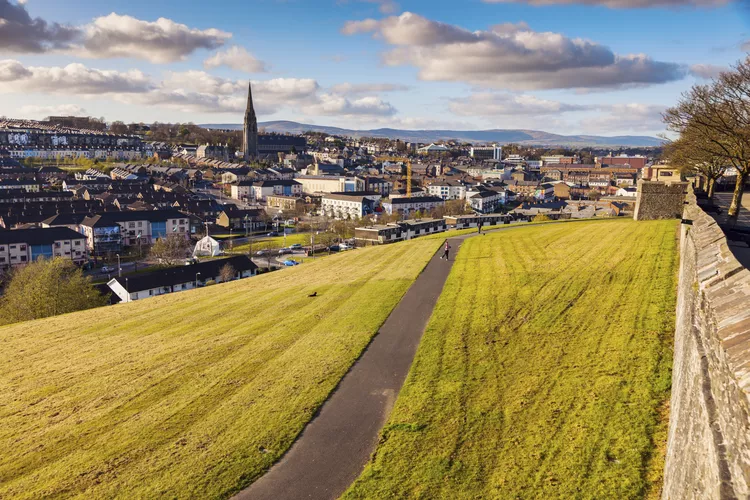The Derry City Walls, or the walls of Londonderry (the name, like everything in “Stroke City,” very much depends on which side of the divide you see yourself to stand), are one of, if not the, most iconic urban sites in Ireland. The walls tell the story of Northern Ireland’s are a living monument to the “Troubles” and are rivaled maybe only by Dublin’s General Post Office for historically important Irish structures. After having been closed to the public for decades, mainly due to their utility as an ideal vantage point for snipers and the odd stone-throw, the peace process has allowed them to become Derry’s most visited attraction.
Description and Overview
Surrounding the old city center of Derry, the city walls are an original and astoundingly complete 17th-century urban fortification with amazing views. You will almost always look down on something, as the walls are not only high in themselves but also straddling a hill. Moreover, the opportunity to literally take a walk through Irish history makes this site one of the most iconic urban locations in Ireland and holds a strong connection to the history of Northern Ireland. However, the walk can be slightly somber on wet and foggy days when all is gray and there is not much of a view.
The Derry City Walls were completed in 1618 and were primarily planned as a defense of the prosperous city against Irish raiders from Donegal. They reach heights of up to 26 feet and widths of up to 30 feet, enclosing the old merchant city. The walls earned their immortal place in Irish history through the defiance of Derry’s Protestant apprentice boys, whose slamming of the gates in the face of an approaching Catholic army made the Walls of Derry an iconic emblem of Loyalism and Unionism.
Siege of Derry
The Derry City Walls are a must-visit when you are exploring the “Maiden City” (so-called because her defenses were never breached). Derry may not be abundant in natural beauty, but the rich history of the city coupled with its architecture makes it a worthwhile destination. Excluding the city walls, Derry stands out as one of the few cities in the British Isles fortunate enough to maintain its complete town walls, serving as a robust defense for the town and its Protestant heritage.
The Walls of Derry gained instant fame within the Protestant church when the town’s garrison was on the brink of surrender to King James’ forces in 1688. During this episode of the Williamite Wars, the approaching army seemed destined to win, and the soldiers tasked with defending the city aimed to hasten the inevitable to gain concessions. However, fervent local Protestants galvanized a group of apprentice boys who, with a resounding cry of “No Surrender!,” took control of the gates and slammed them shut. This bold move initiated the Siege of Derry, a pivotal moment in Ulster—and Irish—history.
What to Expect
Today, visitors can walk the length of the walls and witness views of a community that remains divided, even after years of the Peace Process. You may gaze down into Protestant areas that assert they are “still under siege,” while also spotting a somewhat fortified police station adjacent to the cathedral. Additionally, an unassuming church holds photographs of the destruction after an IRA bomb sent a pillar crashing through its roof. From a battery upon which cannons stood until recently, you can look down on “Free Derry”—the Catholic Bogside, a site of many disturbances, including the notorious event known as “Bloody Sunday,” when British paratroopers opened fire on a Civil Rights March.
With all this recent history in plain view, it is no surprise that many visitors seem less interested in the fortifications themselves. However, the distinctive outline of a walled town is still traceable, so take your time to explore it. The Walls of Derry are highly recommended for a journey into Irish history. They are generally open during daylight hours and are quite safe to walk—just refrain from climbing. You might also consider joining a guided walk, which can be organized through the tourist information center if you desire more comprehensive background information.




